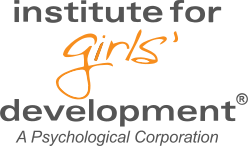Girls, women, and their bodies! This is certainly not a new topic to any of us. Those of us who watch TV, use the internet, read magazines, or simply drive down California freeways cannot escape today’s popular media images of the “ideal” female body. And if you were interested in finding information about how to properly care for the body, you certainly don’t have to go beyond the internet or your mailbox.
Being a community and social advocate for girls and women’s health, I have been amazed at how many unsolicited advertisements I receive every week for the latest diet “that really works” as well as new exercise programs, gyms and equipment, and nutritional supplements that that could bring me closer to the body of my dreams! With so many external messages focusing on the female body, is it any wonder that the majority of girls and women across the lifespan have so much trouble accepting and loving their bodies? In fact, some research shows that the number 1 wish for teen girls is to “be thinner.” And a recent global study by the manufacturer, Dove, found that only 2% of women would describe themselves as beautiful.
In my first of three articles on helping our daughters (and ourselves!) develop positive relationships with our bodies, I want to broaden our scope: what does it mean to be a girl and woman in today’s world? With so much focus in our media-driven world on the body and physical appearance, I would like to present and restore a more balanced and accurate view of what it means to be a girl, a woman, a person. This perspective, ironically, is what I call Embodiment.
MSN’s Encarta dictionary defines ’embody’ as, “to incorporate into an organized whole.” This definition of ’embody’ implies that there are more parts of us than just our physical bodies. This article will help you and your daughters begin to develop an Embodied Perspective.
In conversations with girls, I often ask, “what do you like about your body?” Inevitably, they focus on their appearance–and often emphasize what they DON’T like–their hair, lips, thighs, stomach. Rarely do girls talk about liking how healthy they are, how well they can play soccer, how much they enjoy seeing, how good it feels to be hugged, and how relaxing it is to take a hot scented bubble bath. Yet, these are all aspects of being in our bodies that we can indeed enjoy! Even less frequently do girls (or adults) comment on how satisfying it is to use their brains (another body part!) to solve a math puzzle or how delightful it is to use their imaginations to write a creative story, a poem, a piece of music.
With so much media and interpersonal focus on our physical appearance we forget about the other parts that make up our embodied selves. So, let’s begin our Embodied Perspective by acknowledging that there are other parts of us beside our physical appearance that need attention, nourishment, and expression. What are these other parts of our embodied selves, and how can we attend to these parts of us as well?
I often describe the teen years in particular as a time for asking the “who am I?” questions. “Who am I?” is complex–as we have many different aspects that are all intricately connected to each other–and to our bodies:
• Who am I as a thinking and problem-solving person?
• Who am I as an emotional/feeling person?
• Who am I as a relational/social person?
• Who am I as a physical person?
• Who am I as a spiritual/creative person?
• How do I express and experience these parts of me in my physical/embodied self?
A journaling activity or car ride discussion: A place to begin in applying an Embodied Perspective might be to ask yourself, a group of your own friends, or your daughter some questions like these:
• How are you expressing, attending to and “nourishing” these different parts of you?
• What particular activities do you participate in that express and develop these different parts of you?
• What parts of you are nourished and influenced by the books, TV shows, music, websites, and videogames you incorporate in your daily lives?
• How are these parts of you taken care of at school/work?
• What parts of you often feel neglected and need more attention?
A note about Media Literacy: Because the visual images and media messages aren’t likely to go away in our lifetimes or those of our children, I wonder how we can help ourselves and our daughters develop an Embodied Perspective in which we critically evaluate the images rather than ourselves? Stay tuned in the next article as we continue exploring Embodiment and how we all develop a perspective that empowers us to be our whole selves, developing healthy, loving relationships with our bodies.
Please note: Nothing in what you find here should be construed as medical advice pertinent to any individual. As is true with all written materials, and especially information found on the internet, you must be the judge of what appears valid and useful for yourself. Please take up any questions you might have regarding the content of this website with your psychotherapist or physician.
